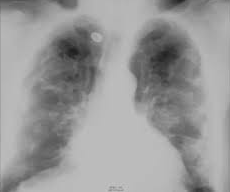Lung Calcification Meaning, Symptoms, Causes, Treatment
Pulmonary calcification is a frequent condition that does not cause any symptoms and is typically found on normal chest X-rays or during autopsies. Calcifications in the lungs can be induced by two major processes:
- Dystrophic form
- Metastatic form
The pulmonary function and clinical symptoms of both types are relatively similar, despite the differences in pathophysiology. Most pulmonary scars, including those caused by tuberculosis, chickenpox, and histoplasmosis, exhibit dystrophic calcification. Even without hypercalcemia, pulmonary calcification can happen in the tracheobronchial cartilage of older people. In chronic hemorrhagic disorders including idiopathic haemosiderosis, lymphangioleiomyomatosis, and venous-occlusive disorder, pulmonary calcification also occurs in conjunction with the deposition of haemosiderin in the lungs.
Lung Calcification Meaning
Lung calcification is a disorder characterized by the presence of tiny calcium deposits in the lung tissues. These deposits are visible on X-rays and other types of medical imaging examinations, and they could be an indicator of a number of underlying diseases. Lung calcification can be brought on by a number of things, such as infections, inflammation, and chemical exposure.

Lung Calcification Symptoms
Most of the time, calcification does not cause any symptoms. On X-rays or CT-Scans, however, doctors might find calcification. In some cases, though, calcification of the lungs can be linked to symptoms like:
- Cough
- Shortness of breath
- Chest pain
- Fever
Lung Calcification Causes
There are various conditions that might lead to diffuse pulmonary calcification. One such condition is pulmonary alveolar microlithiasis, a genetic condition in which calcified spherules develop inside the alveoli. Diffuse calcification can also be a symptom of other disorders, including silica exposure, end-stage mitral stenosis with hemosiderosis, and some viral or granulomatous infections that have resolved. A few examples of these infectious diseases are tuberculosis, histoplasmosis, and varicella pneumonitis. The radiographic appearance consists of calcific opacities that are either diffuse, circular, or punctate in nature. Even though interstitial ossification is uncommon, it has occasionally been documented in patients with idiopathic pulmonary fibrosis who have had long-term busulfan therapy.
Hypercalcemia that persists over time increases the risk of developing metastatic pulmonary calcification. Patients with secondary hyperparathyroidism who are kept on dialysis and have chronic renal failure are most likely to get it.
Lung Calcification Treatment
Treatment is not always necessary for lung calcification, especially in asymptomatic patients. In contrast, your doctor will seek to treat the underlying infection or condition if they determine that it is the root cause of the calcification. Your doctor will recommend you a suitable antibiotic or antifungal if you have a bacterial or fungal disease that is currently active. Infections brought on by schistosomiasis can be treated with the antiparasitic medication praziquantel. In order to bring the inflammation under control, patients with non-infectious causes of granulomas like sarcoidosis are given corticosteroids or other immunosuppressive medicines as treatment.
 Reviewed by Simon Albert
on
January 05, 2023
Rating:
Reviewed by Simon Albert
on
January 05, 2023
Rating:











